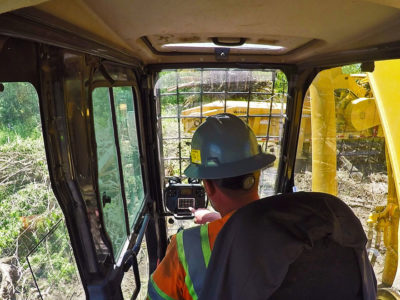Expanding your business by investing in a horizontal grinder or tub grinder is exciting, but it is important to know how to properly clean, feed and maintain your grinder to help keep it productive on the jobsite. Here are a few best practices for a new grinder operator.
Keep safety top-of-mind during operation
Many Vermeer grinders are equipped with either a Thrown Object Deflector or Thrown Object Restraint System. These systems are designed to reduce the quantity and distance of thrown debris. Be sure to consult your machine’s operator’s and maintenance manual for further instructions and safety messages.
Space to breathe
Understanding the wind direction at your jobsite will allow you to position the grinder so the air intake and radiator are upwind. This allows for fresh air to blow throughout the machine.
“Our machines have a dual filter system that helps protect the engine from dust and debris,” said Ted Dirkx, Vermeer sales manager for recycling and forestry. “The machine will actually shut down if those filters get plugged.”
For optimal operation, operators must replace these air filters on a regular basis. Review your machine’s maintenance manual to make sure air filters are being replaced properly.
“If wind is blowing dust quickly, the air filters can fill up in about 45 minutes,” said Dirkx. “But if you rotate the machine in order to take in cleaner air, it could last all day.”
Feeding the grinder
With materials of all shapes and sizes, it’s crucial to feed the grinder properly.
“As a general rule of thumb, less can mean more through a grinder,” said Dirkx. “Just because it fits in the infeed, does not mean it will grind with the same efficiency.”
Loading a moderate amount lets the machine efficiently process the material at a productive rate. Do not overfeed the grinder because it could be less efficient in its feeding.
What if you have a whole tree you want to grind? You can do it — following a certain feeding method. In this case, it is wisest to feed the trunk-end of the tree first. This minimizes branches spreading out while feeding.
Another option when dealing with large-diameter material is to use a shear and break it into smaller pieces. For example, using a shear to split a larger-diameter oak in half could allow for it to grind faster than the entire log at once.
“When grinding big material, spending time prepping the material to fit into the machine better will allow you to maximize productivity,” said Dirkx. “It can really make a big difference, especially with larger-diameter trees or stumps of an awkward shape or size.”
Minimize contamination
Vermeer grinders are equipped to efficiently grind wood, but other materials entering the machine can prohibit that. How you grab and handle the material before loading it can impact your control over contaminates getting into the grinder.
“When you’re grabbing material, grabbing from the topside allows you to inspect smaller quantities and gives contaminants the chance to fall out,” said Dirkx. “You can also grab from the top and fluff the material to allow for contaminants to fall out that way.”
It’s important that any steel is removed from the pile before loading into the grinder. If it were to strike a part of the grinder, the damage to the machine could be costly.
The Vermeer Damage Defense system detects certain metal contaminants in the hammer mill through vibration and automatically shuts down the machine when detected. This allows for the operator to inspect and remove that contaminant with minimal damage to the grinder. This feature is available on most Vermeer grinders.
Daily maintenance
Cleaning out the grinder on a daily basis is important for the life of the machine.
“Grinders are very maintenance intensive,” said Dirkx. “For every eight hours spent grinding, one hour should be spent cleaning, greasing or on other maintenance.”
Seeing the details of your machine each day allows you to be proactive when you see potential issues. Inspection of the hammer mill area is critically important during daily maintenance. This will help you to identify when it is time to change cutter tips. Refer to your machine’s maintenance manual for more details on required maintenance.
Horizontal grinders and tub grinders can be an asset to your productivity, especially when you apply these best practices. For more information on grinders, contact your local Vermeer dealer.
Always refer to the product’s operator’s and/or maintenance manual for safety messages and further instructions. Vermeer Corporation reserves the right to make changes in engineering, design and specifications; add improvements; or discontinue manufacturing at any time without notice or obligation. Equipment shown is for illustrative purposes only and may display optional accessories or components specific to their global region. Please contact your local Vermeer dealer for more information on machine specifications.
Vermeer and the Vermeer logo are trademarks of Vermeer Manufacturing Company in the U.S. and/or other countries. © 2022 Vermeer Corporation. All Rights Reserved.
